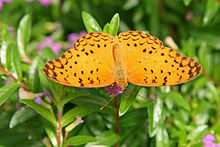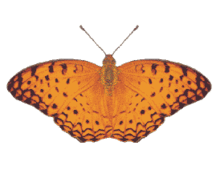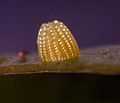Phalanta phalantha
| Common Leopard | |
|---|---|
 | |
| Phalanta phalantha in Bangalore, India | |
| Scientific classification | |
| Kingdom: | Animalia |
| Phylum: | Arthropoda |
| Class: | Insecta |
| Order: | Lepidoptera |
| Family: | Nymphalidae |
| Genus: | Phalanta |
| Species: | P. phalantha |
| Binomial name | |
| Phalanta phalantha (Drury, [1773])[1] | |
| Synonyms | |
| |
The Common Leopard or Spotted Rustic (Phalanta phalantha) is a sun-loving butterfly of the Nymphalid or brush-footed butterfly family.
Field Characteristics
_mating_with_newly_imerged_butterfly_in_Hyderabad%2C_AP_W_IMG_9382.jpg)
The Common Leopard is a medium-sized butterfly with a wingspan of 50–55 mm with a tawny colour and marked with black spots. The underside of the butterfly is more glossy than the upper and both the male and female are similar looking. A more prominent purple gloss on the underside is found in the dry season form of this butterfly.[2]
Distribution and subspecies
The butterfly is found in Subsaharan Africa and southern Asia (including Bangladesh, Sri Lanka, and Burma) in a number of subspecies.
- Phalanta phalantha phalantha
- Phalanta phalantha luzonica Fruhstofer (Philippines)
- Phalanta phalantha columbina (Cramer) (southern China, Hainan and possibly Taiwan)
- Phalanta phalantha araca (Waterhouse & Lyell, 1914) (Darwin)
- Phalanta phalantha aethiopica (Rothschild & Jordan, 1903) (Madagascar, Seychelles, Aldabra, Comoro, Tropical Africa)
- Phalanta phalantha granti (Rothschild & Jordan, 1903) (Socotra Island)
Status
Widely distributed and abundant. To the tops of hills in Sri Lanka and southern India and up to 3000 m in the Himalayas. The whole of Subsaharan Africa.
Habits
_looking_at_the_kill_W_IMG_9370.jpg)

Sun loving and avoids shade. Seen in the plains, gardens, and edges of clearings. Has active and sharp flight movements. Visits flowers regularly especially Lantana, Duranta, Meyenia laxiflora, Gymnosporia montana, and thistles. Often seen mudpuddling from damp patches in the ground, either alone or in groups. A regular basker with wings spread wide open. It is commonest in dry areas and dry weather and absent from the wetter parts of India during the monsoon. It often perches on edges of clearing with wings half open and has the habit of chasing away other butterflies and guarding its territory.[2]
Larval host plants
Foodplants are species of family Bixaceae. It has been recorded breeding on Flacourtia indica, Flacourtia montana, Smilax, Xylosma longifolium,[3] and Salix.
Larval host plants recorded from families Acanthaceae, Compositae, Flacourtiaceae, Primulaceae, Salicaceae, Rubiaceae, Violaceae and specific plants are Barleria prionitis, Canthium parviflorum, Coffea arabica, Dovyalis caffra, Dovyalis gardnerii, Dovyalis hebecarpa, Dovyalis macrocalyx, Dovyalis rotundifolia, Flacourtia indica, Flacourtia inermis, Flacourtia jangomas, Flacourtia montana, Flacourtia ramontchii, Mangifera indica, Maytenus buchanii, Melaleuca leucadendra, Petalostigma quadriloculare, Populus alba, Populus × canescens, Populus deltoides, Salix babylonica, Salix tetrasperma, Salix warburgii, Scolopia chinensis, Scolopia oldhami, Scolopia scolopia, Smilax tetragona, Tridax procumbens, Trimeria grandifolia, Xylosma racemosa.[4]
Life cycle gallery
-

Egg
-

Larva
-
_mating_with_newly_imerged_butterfly_in_Hyderabad%2C_AP_W_IMG_9385.jpg)
Mating with newly emerged butterfly from pupa in Hyderabad, India
See also
- Nymphalidae
- List of butterflies of India
- List of Butterflies of India (Nymphalidae)
References
- ↑ Phalanta phalantha, Site of Markku Savela
- ↑ 2.0 2.1 Kunte, Krushnamegh (2000). Butterflies of Peninsular India. University Press, Hyderabad, pp. 122–124.
- ↑ Kunte, K. (2006). Additions to the known larval host plants of Indian butterflies. J. Bombay Nat. Hist. Soc. 103(1):119–121.
- ↑ HOSTS - a Database of the World's Lepidopteran Hostplants (http://www.nhm.ac.uk/research-curation/projects/hostplants/) accessed on July 2, 2007.
- Wynter-Blyth, M.A. (1957). Butterflies of the Indian Region. Bombay Natural History Society, Mumbai, India.
| Wikimedia Commons has media related to Phalanta phalantha. |